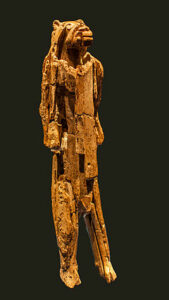
I have much enjoyed Neil MacGregor’s BBC Radio Series ‘Living with the Gods’. It is so nice to hear information from prehistory discussed alongside that from historical sites, all put into the context of everyday life today. Or, rather, everyday lives – his outlook has a chronological and geographical scope that is truly impressive.
I just have one, tiny, niggle and it arrived early in the series, in the “Lion Man’ episode, broadcast towards the end of October. The Lion Man sculpture is wonderful, just over 30cm tall, made of mammoth ivory, with the head of a lion and the body of a man. It is about 40,000 years old, and was found during excavations in a cave known as Hohlenstein-Stadel, in southern Germany. The figure is incredibly detailed, it is one of those pieces where you see new features every time you look at it. It is an iconic figure, not only for its prehistoric values: it was excavated on the eve of war in 1939, and lay in storage until the 1960s when the fragments of ivory were first pieced together. Further restoration work has continued, on and off, into recent times. I doubt that work on the Lion Man has finished.
My issue is this: MacGregor describes the makers of the Lion Man as members of a community for whom everyday life, mere survival, was a struggle. He notes that experimental archaeology suggests that it would have taken around 400 hours to create the figurine, and asks: ‘why would a community living on the edge of subsistence, whose primary concerns were finding food, keeping that fire going, protecting children from predators, allow someone to spend so much time away from those tasks?’ He paints an evocative picture.
I can’t argue with the fact that life for the Upper Palaeolithic communities of central Europe was very different to ours, and much less comfortable in so many ways. They were, after all, living in the middle of the last glaciation, just as the world was starting to cool to the extremes of the Late Glacial Maximum. They were hunter-gatherers, and mammoth were not the only exotic (to us) animal to roam the plains and mountains around them. Yet, the hunter-gatherer lifestyle is not always simply a mere quest for survival. Curiously, much research suggests that it is farmers who, all too often, lack leisure and struggle to make ends meet. Surely, the Lion Man is a pointer that the lives of those early hunters were more complex than we might once have thought. While it certainly suggests that they were only too aware of the fragility of life, even of their community, it is surely also a clear indication that they had time for so much more than survival?
There is, of course, plenty of other art from the period, even another, smaller, less well-preserved, lion man, from Hohle Fels some 20km away. As MacGregor points out, the people who made pieces like these were part of a deep tradition, they were certainly not novices, but for me he still seems to miss the point. These were communities for whom life encompassed so much more than the straightforward quest for food and personal safety. In the radio programme Jill Cook from the British Museum and Clive Gamble from the University of Southampton, tried, valiantly, to inject the feeling that these were not mere squat grunting savages, but I felt let down, somehow, that the enduring message was one of surprise that these simple people, so long ago, were capable of such wonders.
For me the message of the Lion Man is a powerful evocation of all that archaeology misses. It shows us that we should beware of misjudging our ancestors. It demonstrates that the evidence we excavate is but a tiny proportion of the goods and chattels of those who came before us. It is a stark reminder that, for all our scientific wizardry, we will never know what went on inside their heads. We will always miss out on the emotions, the successes, and the failures, of living in the past.
We can’t know the meaning of the Lion Man for the community who made, and used it. MacGregor is right to point out that it suggests a community with significant narratives and shared beliefs. It may even represent the physical manifestation of religion. In a way, that is detail. In the twenty-first century, the Lion Man is, once more, a powerful symbol, a symbol that can transcend time and connect us to the people of the past. We should be careful of underestimating them.
You must be logged in to post a comment.